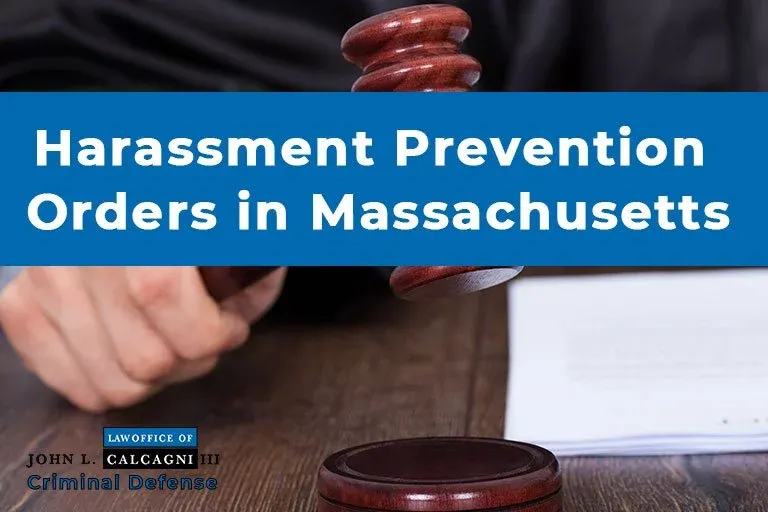
Under Massachusetts, there are two types of restraining orders.
- The abuse prevention order provides protection from physical or sexual harm caused by a family member, spouse, or dating partner.
- The harassment prevention order is aimed at restraining others from harassing, stalking, or sexually assaulting another, no matter the relationship between them.
Harassment prevention orders in the Commonwealth.
Table of Contents
A plaintiff may seek a Harassment Prevention Order, or 258E Order, from a judge if they are suffering from harassment because:
Someone has committed three or more of acts:
- That were willful and malicious, meaning done intentionally and for the purpose of cruelty, hostility, or revenge;
- Were aimed at the plaintiff;
- Were intended to cause the plaintiff fear, intimidation, abuse (causing or attempting to cause physical harm, or causing fear of imminent serious physical harm) or damage to property; and
- Did in fact cause the plaintiff fear, intimidation, abuse or damage to property;
Or
- Someone forced the plaintiff to have sex or threatened the plaintiff to have sex on at least one occasion;
Or
- Someone has committed one of the following crimes against the plaintiff on at least one occasion:
- Indecent assault and battery
- Rape
- Statutory rape
- Assault with intent to rape
- Enticement of a child
- Criminal stalking
- Criminal harassment
- Drugging for sexual intercourse
Obtaining a harassment prevention order
In order for a plaintiff to obtain a harassment prevention order, the process begins with going to court. There, the plaintiff will be required to fill out the necessary forms, including a complaint that describes the alleged incident(s) of harassment.
Emergency harassment prevention order
If the court is closed and the plaintiff feels he or she is in immediate danger of harassment, the plaintiff may try to obtain an emergency harassment prevention order by visiting the police station. Police will then contact a duty judge, who may issue the order by telephone, but only if the judge believe there is a substantial likelihood of immediate danger of harassment to the plaintiff. If the judge issues the emergency order, it will only remain in effect until the close of business on the next day that the court is open. As such, the plaintiff must visit the court beforehand to complete the necessary documentation to request a harassment prevention order.
Ex parte hearing
When the plaintiff files for a harassment prevention order at court, there will typically be an ex parte hearing, where the judge will read the complaint and ask the plaintiff questions about the allegations under oath. If after doing so the judge believes there is a substantial likelihood of immediate danger of harassment, the court will issue an ex parte order. An “ex parte” hearing is one that is held without the defendant present. Because of this fact, an ex parte order may only provide temporary relief that does not exceed 10 business days.
If the ex parte order is issued, the defendant must then be “served,” or given papers that notify him or her of the temporary harassment order and the date of a full hearing related to the order. On the date of the full hearing, the plaintiff must appear, otherwise the temporary order will expire or be terminated. If the defendant fails to appear, the hearing may proceed in his absence where the judge may grant the plaintiff the relief of ax extended order that remains in effect for up to one year. At the hearing, both parties have the right to be represented by counsel, to present evidence to support or negate the allegations of abuse set forth in the complaint, and to cross-examine each other as well as any other witnesses that may be called.
If a harassment prevention order is issued
The court may order the defendant (1) not to abuse or harass the plaintiff; (2) not to contact the plaintiff, unless authorized by the court; (3) to stay away from the plaintiff’s household or workplace; and (4) to pay the plaintiff for any losses suffered as a result of the harassment, including but not limited to loss of earnings, out-of-pocket losses for injuries sustained or property damaged, cost of replacement locks, medical expenses, cost for obtaining an unlisted number and reasonable attorney’s fees.
Unlike abuse prevention orders, harassment prevention orders cannot (1) order the defendant to vacate the home; (2) include orders about custody, visitation or temporary support; (3) order the defendant to pay the plaintiff for moving expenses; or (4) order the defendant to surrender firearms, firearms licenses, or identification cards.
If a harassment prevention order has been issued against you
A violation of the order constitutes a criminal offense. A violator can be fined up to $5,000 or imprisoned for up to 2 ½ years in the House of Corrections, or both. Someone convicted under 258E must also pay a fine of $25. Further, the court may order that the defendant complete an appropriate treatment program based on the circumstances of the offense and may also order the defendant to pay the plaintiff for the damages described above. Any person who has been referred to a treatment program as a condition of probation must also pay $350.
While a particular harassment prevention order may have unique terms depending on the relationship between the plaintiff and the defendant, all orders prohibit harassing, contacting, or coming within a certain distance of the plaintiff. “No contact” means the defendant may not contact the plaintiff personally or through others, via letters or email, phone calls, gifts, or social media. However, many defendants are unaware of what may or may not constitute a violation, and find themselves facing a criminal charge.
If you have received notice of a harassment prevention order, or any other type of restraining order and need qualified and experienced defense, contact the Law Office of John L. Calcagni, III at (508) 213-9113 for a free consultation.

